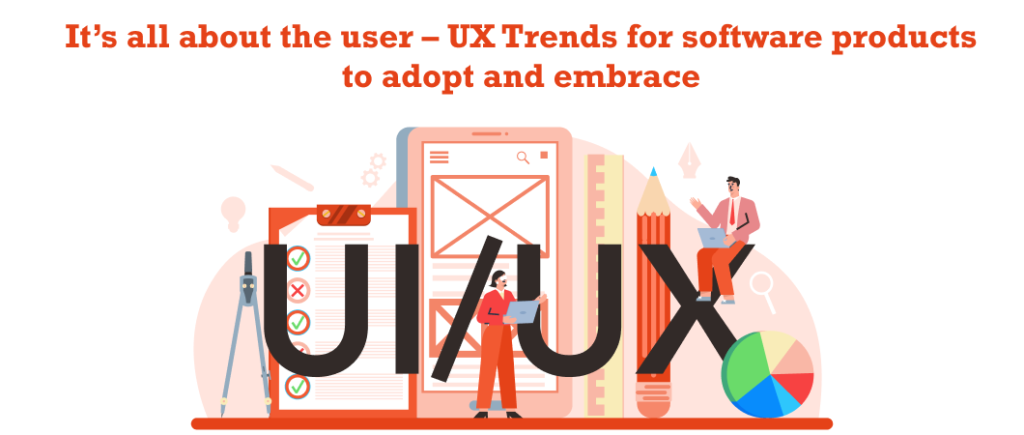Last updated on August 31st, 2023
In a world where many digital products vie for users’ attention, user experience (UX) becomes a key differentiator to success. Research shows that 89% of users will choose competitors’ products, and 90% will stop using an app if the UX is poor.
Hence, it’s essential to know and incorporate the UX trends to keep pace with changing user expectations and competition.
Let’s find out the top UX trends that are making waves in different industries and how product developers can implement them.
Top UX Trends for Software Products
1. Mobile-first UX
Users use mobile phones for shopping, entertainment, paying bills, and other purposes. In 2022, mobile devices generated 59.16% of global website traffic. Users worldwide downloaded 255 billion apps. By 2025, over 72.5% of users will access the internet from their smartphones. Thus, building a mobile-first product is crucial for the business’s future.
Product developers should use responsive design practices to ensure that the application works well across all mobile devices running on iOS and Android. Mobile devices provide less real estate than other devices. Hence, developers and designers should first build products for mobile phones. The benefit of this approach is that mobile screens have bandwidth and screen size restrictions. So, developers have to prioritize the core and unique features of the products. It helps them focus on building a minimum viable product (MVP) rather than spending time on non-crucial features.
2. Fast Page Loads
No matter how good the app is, users will exit it if it doesn’t load within three seconds. Studies reveal that the bounce rate increases by 32% when the load time goes from one second to three seconds. Hence, product developers must optimize the pages, stabilize the servers, compress images, and format the files to accelerate the page loading speed.
They could also use content delivery networks (CDN) and accelerated mobile pages (AMP) to deliver content to users quickly and improve mobile page speeds. Product developers should frequently monitor the page loads to identify areas of improvement and enhance the loading speed.
3. No-code and Low-code for UX
No-code and low-code platforms can democratize UX development and design for companies. They bring flexibility to the applications, eliminate coding barriers, and allow business users with little or no coding knowledge to build applications fast. In a fast-paced business environment, no-code and low-code provide the perfect opportunity for companies to accelerate innovation and quickly customize the UX to meet business needs.
4. Accessibility
The European Union members recently passed the European Accessibility Act, which necessitates all companies to adopt a common set of accessibility standards by 2025. All companies operating in the member states must build accessible products and services like computers, smartphones, operating systems, eCommerce, and banking services. The aim is to create inclusive products and services that the elderly and differently-abled individuals can use easily without any barriers. It demonstrates inclusiveness and helps build the company’s reputation.
Although the law is limited to companies operating in European member states, companies worldwide must develop products that are accessible to everybody. Developers can begin by using the W3C guides to assess the websites and mobile designs for accessibility. Alternatively, they can implement features like voice-to-text or text-to-speech to help people access the websites easily.
5. Personalization
According to the GIPSI report, the fact that there have been 53K conversations around personalization shows the urgent need to personalize UX and delight users. The report recommends using anticipatory design to build the application. Build the features by considering factors like season, temperature, geo-locations, browsing trends, and users’ likes and interests.
Technologies like artificial intelligence (AI) and machine learning (ML) can further tailor the experiences and improve customer engagement and retention. According to Imane Adel, the vice president of Paymob, personalization will become that one big thing in UX in the next five years.
6. Cross-device UX
Users use multiple devices to perform different activities and often switch between devices for convenience. For example, they watch a movie on their mobile phone while traveling and on TV at home. Statista’s research shows that in 2023, users will use an average of 3.6 devices.
Since these devices are connected, product developers must focus on delivering a seamless experience across all devices. In other words, they must ensure the user can pick up from where they left off without interruption. To deliver that kind of experience, product developers should build features that work consistently well across all devices, browsers, and operating systems. There must be continuity in the experience.
7. Metaverse and Web 3.0 Compliant
Although Metaverse and Web 3.0 are nascent, companies are taking them seriously to build immersive and intuitive experiences. Technologies like Augmented Reality and Virtual Reality (AR/VR) will soon become a mainstay and shape the future of UX. Immersive experiences will become a critical tool to improve user experience.
However, before jumping on the bandwagon, determine if it would benefit the product users because concepts like Web 3.0 are multi-disciplinary. It requires extensive planning. So, only start working on it if it serves your users. Focus on other trends that could genuinely provide a memorable experience to users.
Conclusion
Many UX trends promise to change how users interact with the products. Some trends, like accessibility and mobile-first designs, are urgent, while some are purely cosmetic. Product developers must move beyond cosmetics to focus on the ones that will add value to the business. They have to maneuver through various strategic concerns like end-point security, app performance and scalability, network strength, security, and product architecture to build the product.
At Forgeahead, our team of UX architects and UI designers understand the significance of building products with superior user experiences. That’s why we use a multi-pronged approach of research, planning, exploring, and creating to develop beautiful products from scratch or refurbish the existing ones to make them more appealing to users.
To know more about our UX and UI offerings, contact us.



